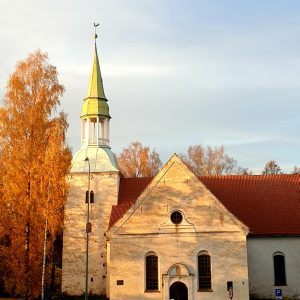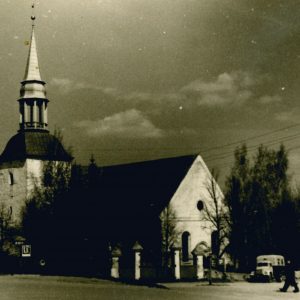Rauna Evangelic Lutheran Church
The precise date of the construction of Rauna Church is unknown. The first mention of Rauna Church in written sources dates back to 1457.
Since first built, Rauna Church has significantly changed, as it was repeatedly destroyed and rebuilt. It was damaged during Livonian War, as well as during the Swedish – Polish war, and the church was restored every time. Information is available that, in 1613, the church did not have the roof, which was restored only in 1636. It was mentioned in the protocol of church visitation of 1691 that the roof of Rauna church is covered with flat wooden shakes and has an earthen clay floor.
In 1702, the army of the Russian Empire under the command of Sheremetyev burnt Rauna Church down, and the visitation protocol of the church of 1724 mentions that the church has collapsed. The tower of the church was restored in 1736, the new tower obtained a baroque shape and has retained it to date.
Rauna Church has undergone significant reconstructions over time. In 1793 – 1794, a sacristy was added to the church. In 1803 – 1804, the most extensive reconstruction in the history of the church occurred – the wall at the southern side of the church was destroyed and a section of the church was added. Currently the main entrance to the church is situated in this part, as well as the altar of the church was transferred from the eastern side to the northern wall of the church. It was done to expand the church, because in the late 18th century the congregation of Rauna parish consisted of 10,000 members.
After the World War II, despite Soviet ideology and limitations, the congregation of Rauna church remained active. Services have been held, celebrations, wedding and christening ceremonies have been organised. Up to the 50s of the 20th century festive consecration ceremonies of new congregation members were organised. In 1972, the 710th anniversary of Rauna Church was celebrated at Rauna Church. Thanks to the wisdom of the pastors, parish managers and members of Rauna congregation, Rauna Church and its cultural and historical heritage was preserved, saving the church from fate that overtook other churches. In January 1991, Rauna Church was the site that the participants of barricades from Rauna Parish departed from in order to join barricades in Riga. Before departure, the pastor of Rauna congregation held a sermon and blessed the departing people.
Gallery
Travel objects
- Rauna Castle
- Rauna Castle Courtyard
- Rauna Park and Rauna Manor Estate
- Rauna Evangelic Lutheran Church
- Rauna Agricultural Society House
- Rauna Freedom Monument
- Rauna Mill
- Strads Pub / Rauna Dairy
- Plūme House / Bookshop
- Rauna Parish House
- Rauna Congregation School / Office of Sarkanais Oktobris Collective Farm
- Rauna Devil’s Cave
- Rauna Staburags (Staburags Cliff of Rauna)
- Jānis Cimze Monument
- Rauna “Pārupe” (Left Bank)
- Baižkalns Manor Estate
- Lauktehnika (Agricultural Equipment Station)
- House of Doctor’s Skaidrais Family / House of psychotherapist Jānis Zālītis
- Rauna Hospital
- Rauna Post Office
- Rauna Pastor’s Manor
- The Centre of Rauna and the visit of USSR leader Nikita Khrushchev
- Rauna Cemetery
- Cemetery of Soviet Soldiers, who Died during the World War II
- Rauna Castle Tower
- Intermediate Passages of Rauna Castle
- Rauna Castle Plastering
- Heating and Smoke Channels of Rauna Castle






